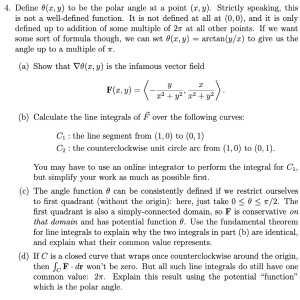Calc 3 Question
Answer
Answers can only be viewed under the following conditions:
- The questioner was satisfied with and accepted the answer, or
- The answer was evaluated as being 100% correct by the judge.
2 Attachments
4.8K
-
Will do in the future didnt realize it took so long. In part C, why did u swap the integration limits?
-
Not part, C, i mean for C2 you integrated from pi/2 to 0. was wondering why u did that instead of 0 to pi/2
-
That is because of the orientation of the path C_2. At the initial point os C_1 we have theta=pi/2, and at the end point theta is zero. You should respect the same order in your definite integral.
The answer is accepted.
Join Matchmaticians Affiliate Marketing
Program to earn up to a 50% commission on every question that your affiliated users ask or answer.
- answered
- 1376 views
- $10.00
Related Questions
- Let $f:U\subset\mathbb{R} ^3\rightarrow \mathbb{R} ^2$ given by $f(x,y,z)=(sin(x+z)+log(yz^2) ; e^{x+z} +yz)$ where $U = { (x, y, z) ∈ R^3| y, z > 0 }.$ Questions Inside.
- Rouche’s Theorem applied to the complex valued function $f(z) = z^6 + \cos z$
- Calculus - 2nd order differential equations and partial derivatives
- Calculating Driveway Gravel Area and Optimizing Cardboard Box Volume
- Find $\int x \sqrt{1-x}dx$
- Work problem involving pumping water from tank
- A bicycle with 18in diameter wheels has its gears set so that the chain has a 6 in. Radius on the front sprocket and 4 in radius on the rear sprocket. The cyclist pedals at 180 rpm.
- Sinusodial graph help (electrical)


